Review and photos by Bokisaurus with additional text and information by Acro-man
This review hits another milestone as it is my 70th one for the blog! Deciding which figure to mark the occasion has proven competitive, but one stood out and pushed my original choice: Wilson.
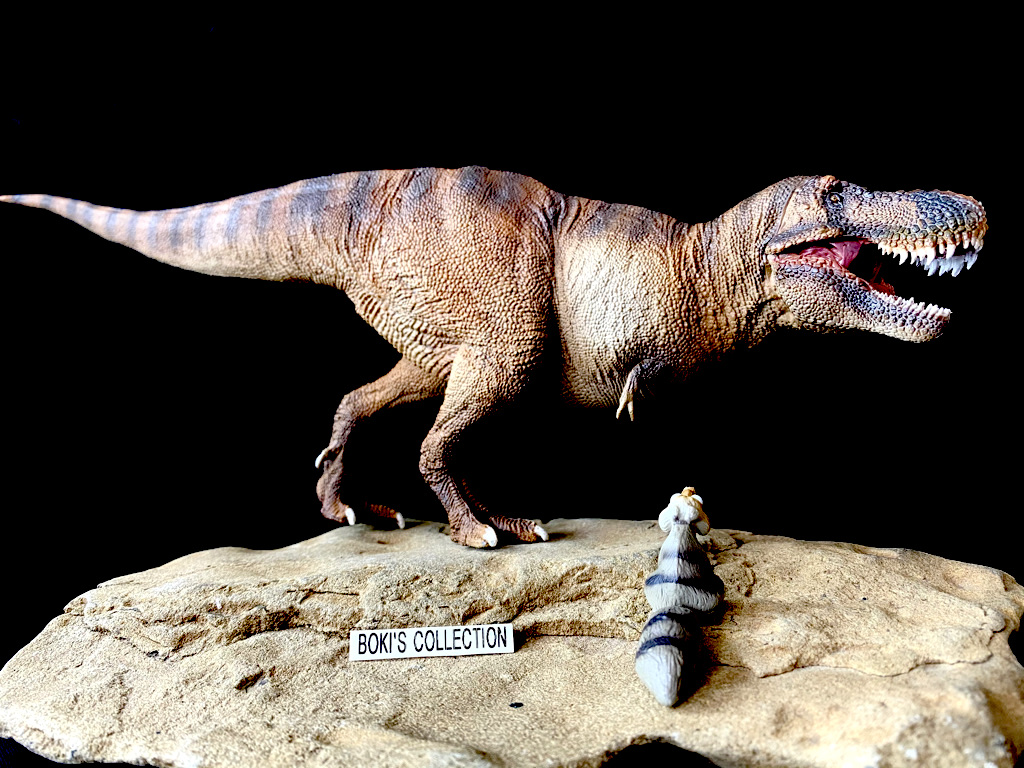
PNSO’s new Wilson V3 hit the market December 2020 and instantly became one of the most polarizing figures to come along, joining the Papo’s Limited Edition Spinosaurus. I have to admit, reviewing such figure is more daunting than meets the eye for a variety of reasons, this especially becomes even more tricky when the subject itself is the most famous dinosaur of all times, after all, with so many reviews already published on the blog is there anything new or much more to say?
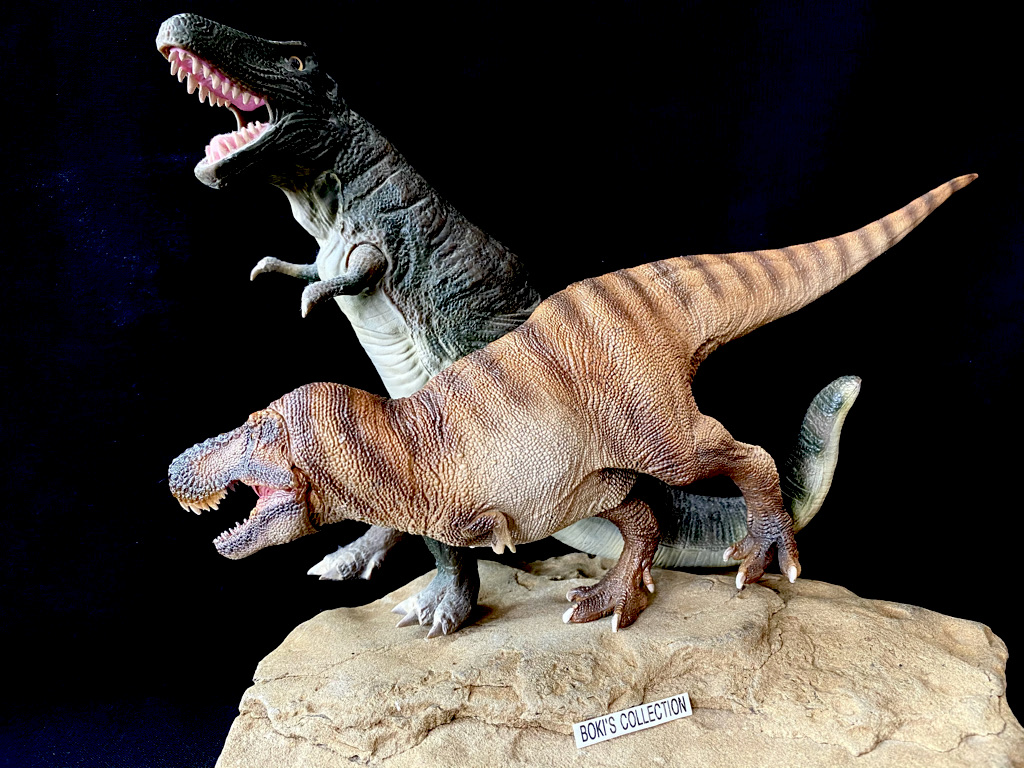
There was a time not that long ago when good, accurate dinosaur figures were a rarity rather than the norm. Today, we are bombarded by an astounding number of accurate quality figures that it’s difficult to catch up or even stop and fully admire them all without too much noisy distraction. With this new level of accuracy, artistic quality, and affordability, we are left wanting even more.

In the last few years, some of the newest figures of the most famous and iconic dinosaurs have been caught in the crossfire of higher expectations and subjected to a magnifying glass lens when scrutinized for any signs of inaccuracies or imperfections. I suppose that it is inevitable for species like Tyrannosaurus rex, and Spinosaurus just to name a few, which has no shortage of figures out in the market, both good and bad, being made over and over again and yet no one seems to have hit the jackpot in producing a figure that a plurality would consider the “definitive” version.

Definitive and Best are two words often interchangably used to describe a figure. But what makes a figure a “definitive” version and why is it, ironically, so hard to find a figure of the most popular and iconic dinosaurs that fits that description? Some of the less common or even obscure species despite being rare in toy figure form have versions that many would consider the definitive. Sure, the constant changing interpretations, fossil evidence, and new knowledge could all be a factor in fueling this debate cycle, and for Tyrannosaurus rex, the big divide between feathered and non-feathered camps makes the debate even more interesting and complicated. But why is it that after so many figures from various brand we still don’t have a definitive version of the Tyrant king ?
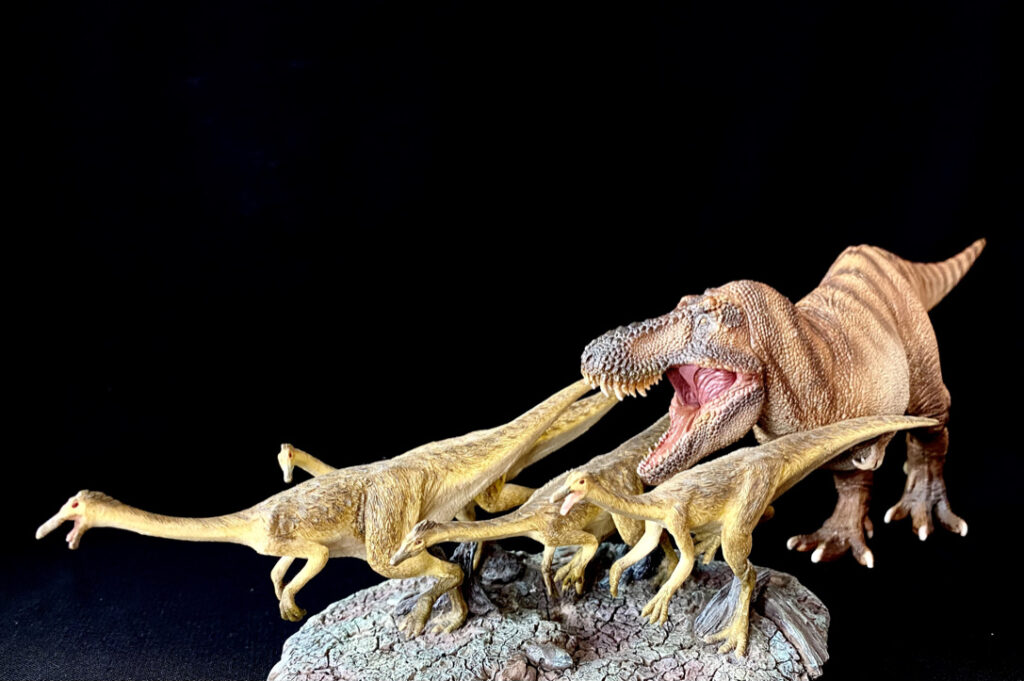
So, the frustration, polarizing opinions and response to this figure are both understandable and confusing for me. The spotlight on the flaws or what some calls inaccuracies/shortcomings of this figure is blindingly harsh. Criticism and feedback are important and has helped shape and lead the way in forcing companies to listen and finally start producing more up-to-date and accurate models. Without such debate and feedback, we surely will still be in the old age of tail-dragging and pronated hands monsters. But there is a fine balance that must be met for such productive conversation to continue. Too much negativity could easily tip the scale and have the opposite effect, drowning out all the positives.
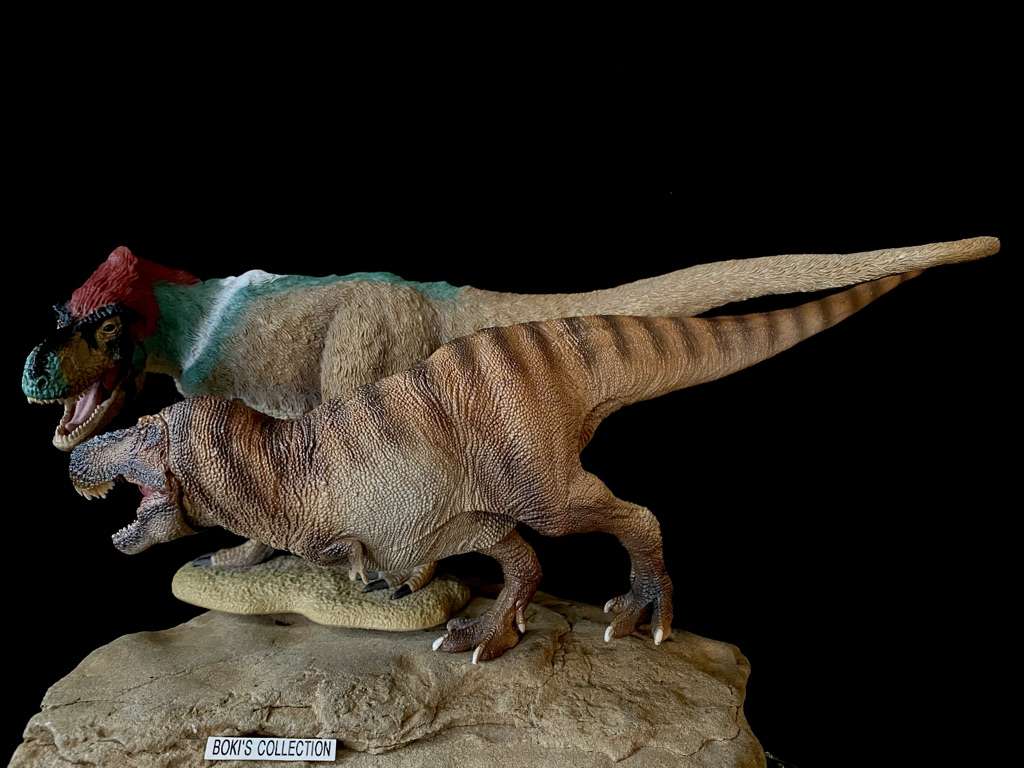
This new figure from PNSO falls into the non-feathered side of the equation and was made with no pretense of having any, so in fairness, I would look at it through that perspective, after all feathers are still a big question when it comes to Tyrannosaurus rex unlike some of its smaller relatives where direct evidence of feathers is fully known.
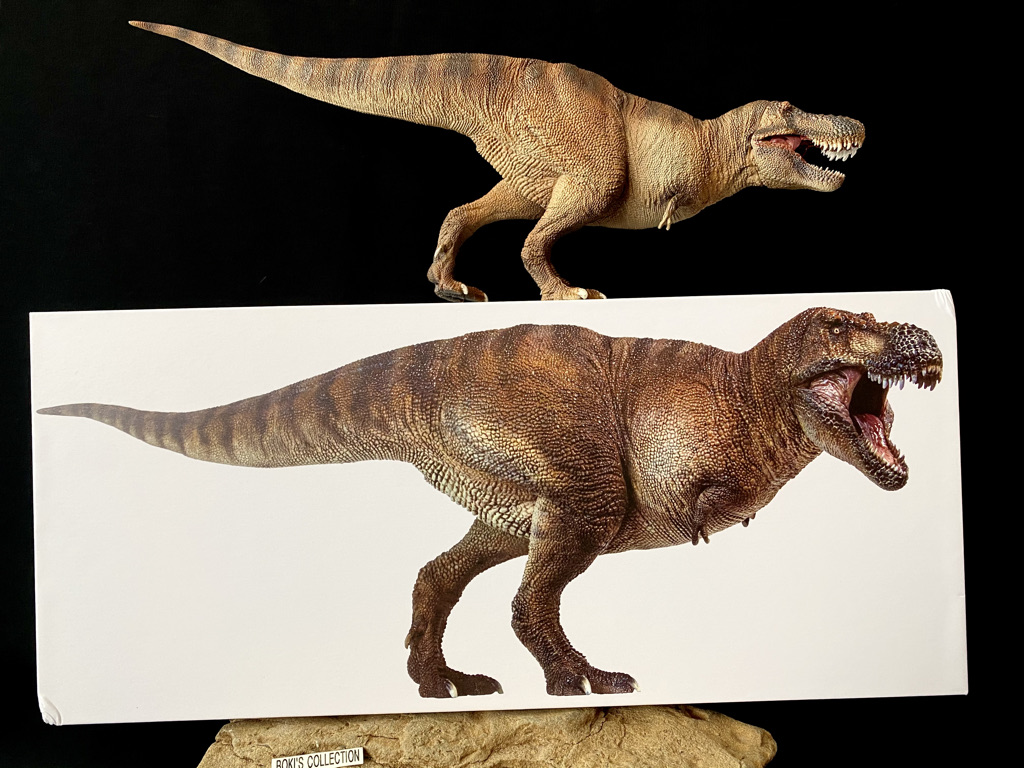
This new version of Wilson is part of the Museum Line series of figures that are more expensive than the medium-priced Prehistoric Animals Models That Accompany Your Growth series. Oddly, unlike others in the Museum series, this figure does not come with a base at all which is a bit confusing and disappointing since the bases are the biggest difference between the two series and what really sets them apart. It does come in similar boxed packaging like others in the series and there is also a clear plastic rod that can be used to help display the figure (more on this later). I guess when you’re this famous, who needs an add-on to make a guaranteed sale? This is particularly obvious when you consider that it is priced like the Museum Line figures, so it would have been nice and easier to justify the high cost if it came with a display base.
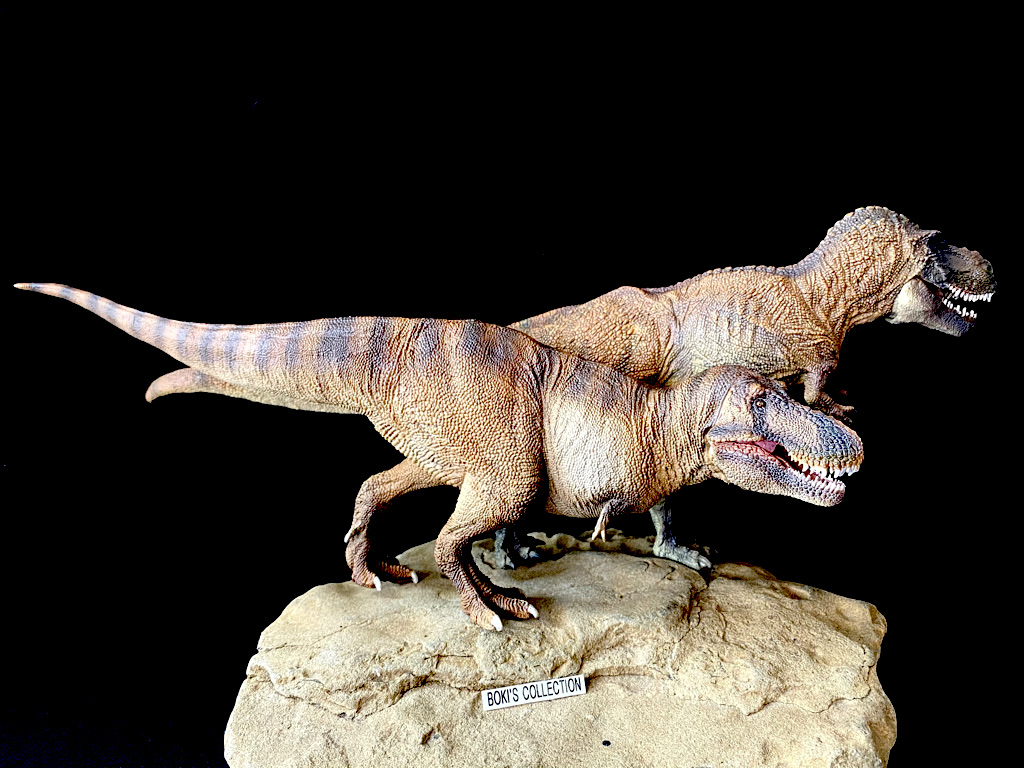
When compared to its predecessor, this new Wilson looks very different and reflects some of the current consensus especially on how its body is depicted. While the old version follows that, until recently, slender looking body form that was popularized in the 90’s, this new one is much bulkier all around. This new bulkier look is perhaps the first thing that will grab your attention since we haven’t really seen this full-figured body in toy form before. The figure is posed with the bulk of its body thrust forward horizontally, its head slightly tilted to the side, and its long powerful tail held straight out and held high countering the front weight. Its articulated jaw gives you the option of how you would like it to be, giving you the opportunity to create your own story which is always fun when arranging a display.
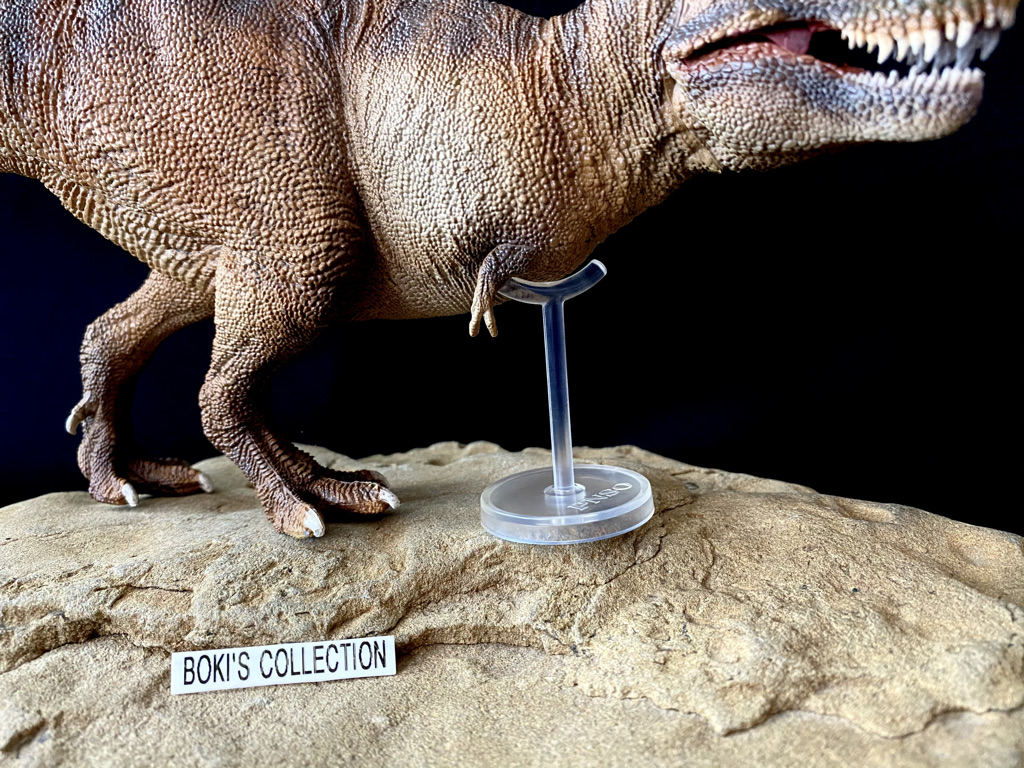
There is a clear support rod that is included to give the legs added support since the figure is heavy and in time would put too much stress on the leg and may cause it to start buckling under the weight. Some of my heavy biped Safari figures including the feathered Tyrannosaur rex has suffered this issue; in time the feet start to slide forward making the once stable figure topple over or lean on its tail. The feet are nicely done and proportioned and you can see some skin covering the digits, this really gives you the impression of the animals weight.
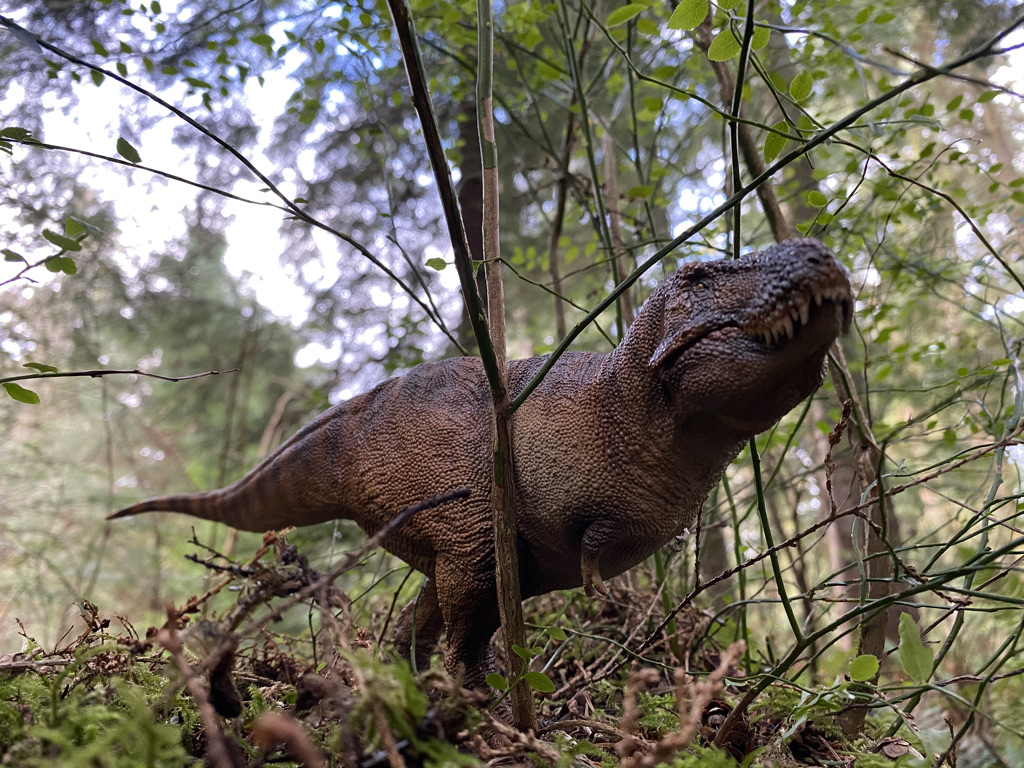
The body is well proportioned from head to toe and full of bulk with its belly and torso fully fleshed out. There are plenty of muscle details and skin folds that complements its overall bulk. The head is big and powerful as it should be and its eyes are placed in the right spot that gives it perfect binocular vision, fully capturing what I felt was the essence of Tyrannosaurus rex.
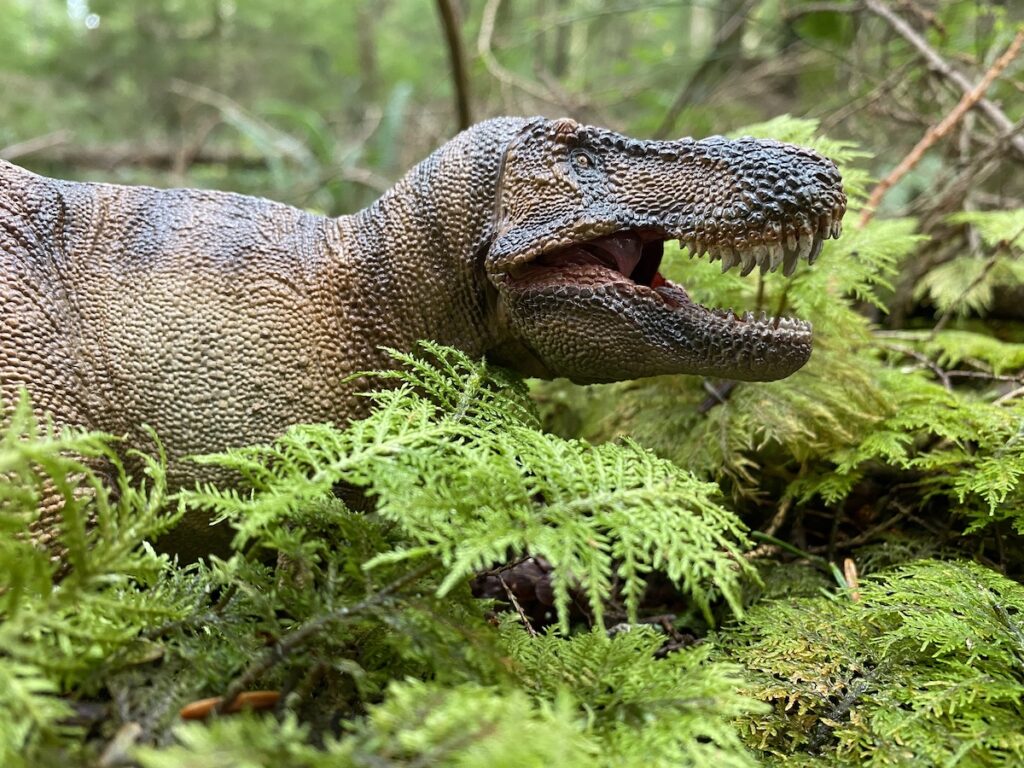
Feathers (lack of it) aside, the two big complain about this figure is the size of its scales and the lack of lips. While both doesn’t bother me, obviously others are. The size of the scales in my opinion is not that exaggerated especially when compared to others out there. I understand that making the size of the scales slightly exaggerated make them pop out more on the finish model than if they are true to scale which would be very hard to see and the figure would end up looking smooth and lacking in details.
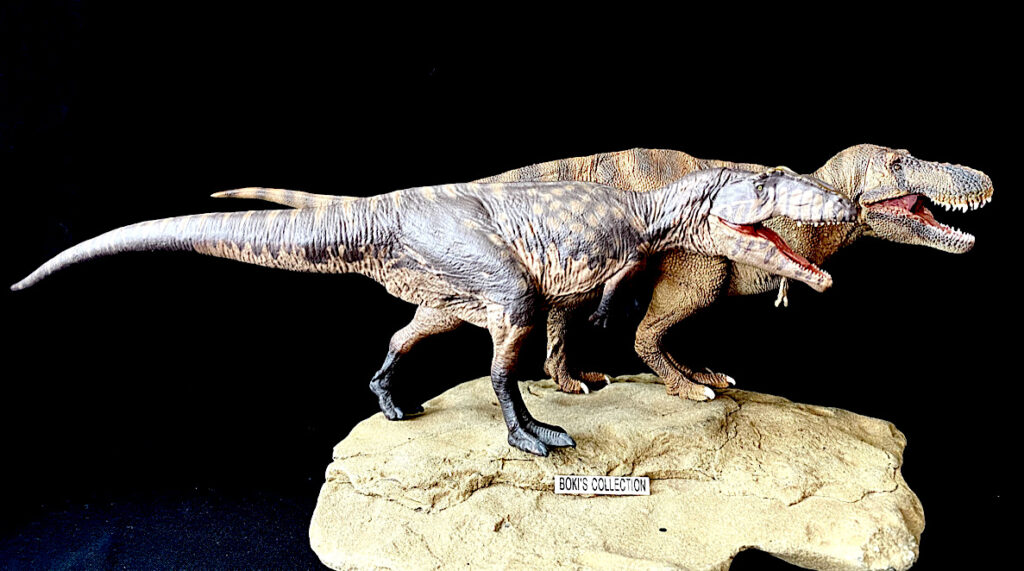
The majority of featherless Tyrannosaurus figures have either a skin so smooth with hardly any details or looking like elephant skin, or the scales are so oversize and without much variations in shape and size they looked like a generic stamped-on. So, I find it refreshing to see the various variety of scales shapes and sizes that we see in this figure. Critics of this figure point out that the scales are oversized and over textured ( I have seen much worst to be honest). It is understandable why the scales are not exactly to scale; if they are sculpted so, it would make the figure look smooth-skinned with hardly any details.
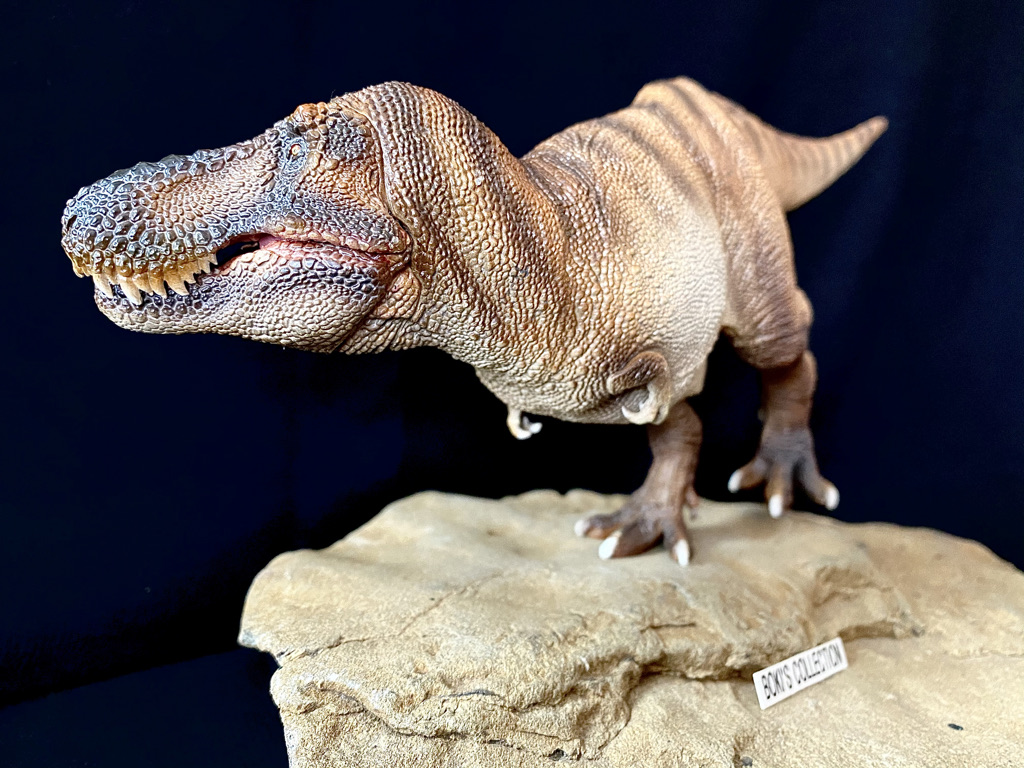
Visually (if you’re a visual person like me), the ability to see those fine scales from a distance is important especially when admiring it from across the room in the comfort of your couch ; these details can still be seen. Close up, be it in photos or in-hand, any figure’s details will be magnified, and this figure is no exception; the viewing distance is an important factor to consider.
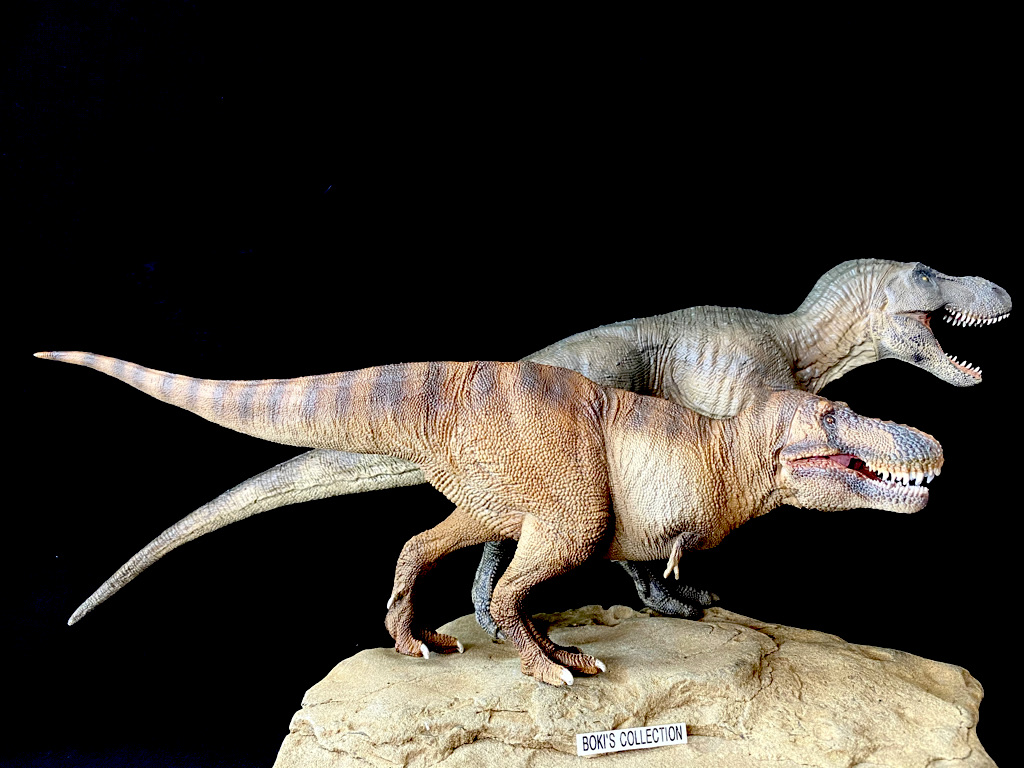
Although scares, there are few skin impressions from T. rex ( and more from its close relatives) and that gives us some idea of their shapes which I feel this figure really captured. As you closely examine such small and delicate sculpting details up close, you can’t help but marvel at the rich variety in shapes, texture, and sizes of those individual sculpted scales as they move across and cover the figure’s body.
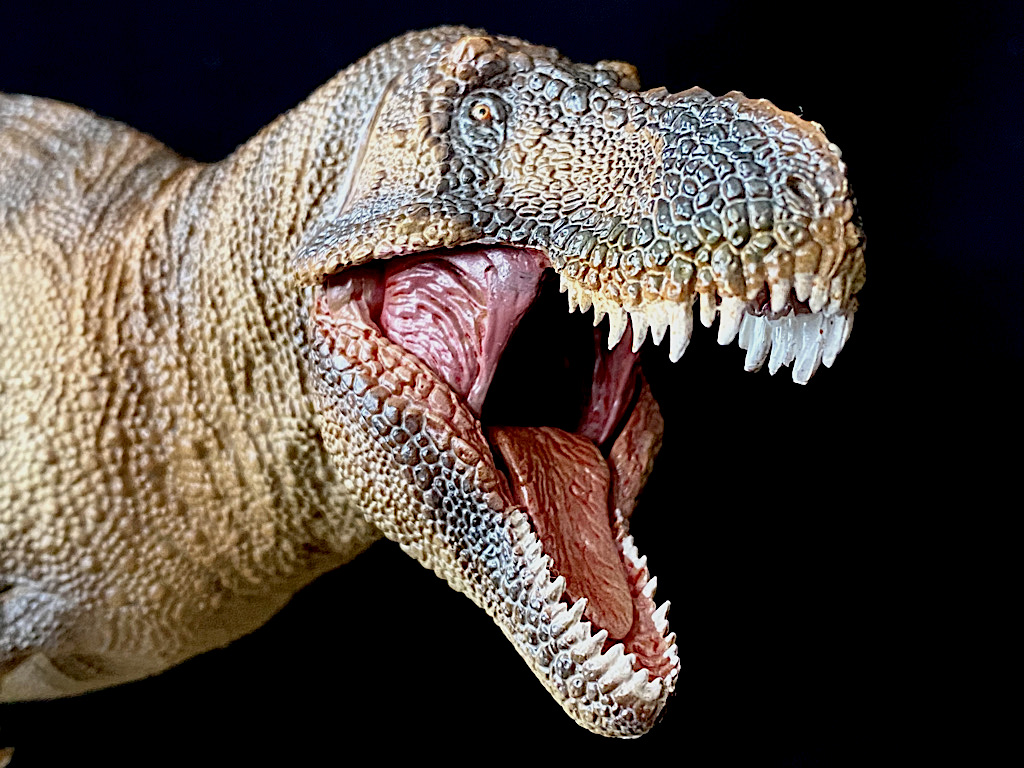
How the teeth and scales that covers them are sculpted is so unique and I have never seen anything like it before. Instead of lips, you see large scales just above the teeth. The way those individually sculpted teeth are painted are clean and despite their small size show nice color transition and not just immaculate white. The jaws are articulated and when kept shut, the lower one fits nicely under the much wider upper one.
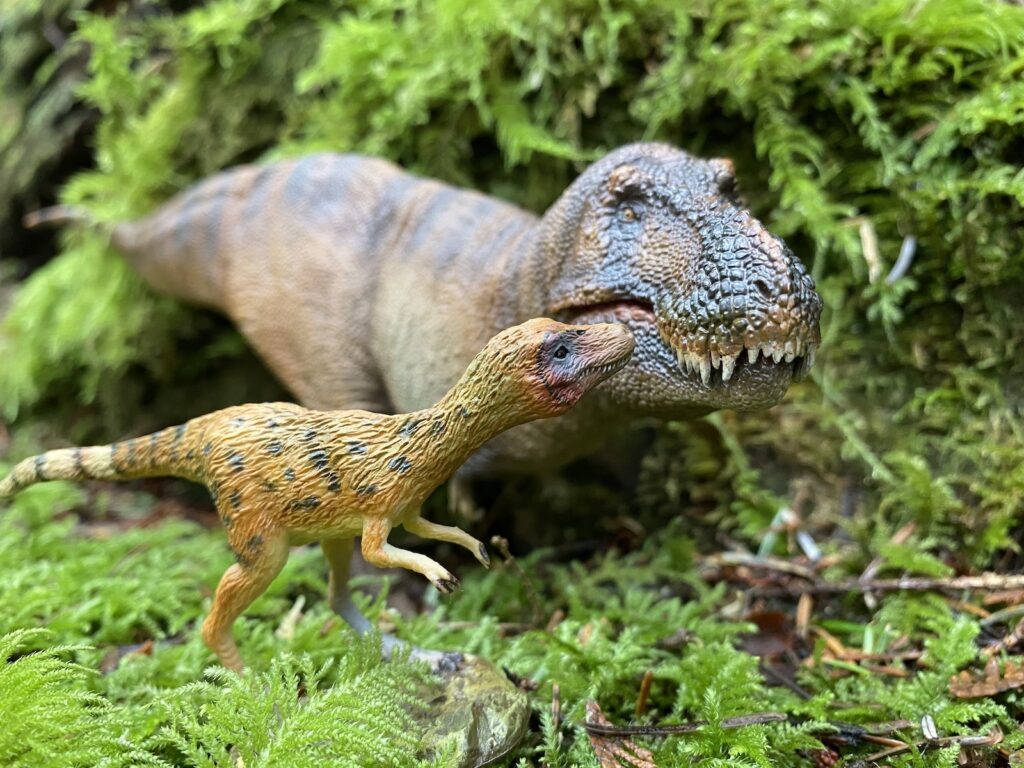
The inside of the mouth is also very well done and attention to small details are surely to be commended on as even this often-hidden area of the mouth is packed with details; also, the color is not just pink as in most figures. There are areas of the inside of mouth where there are spots of bright glossy red.
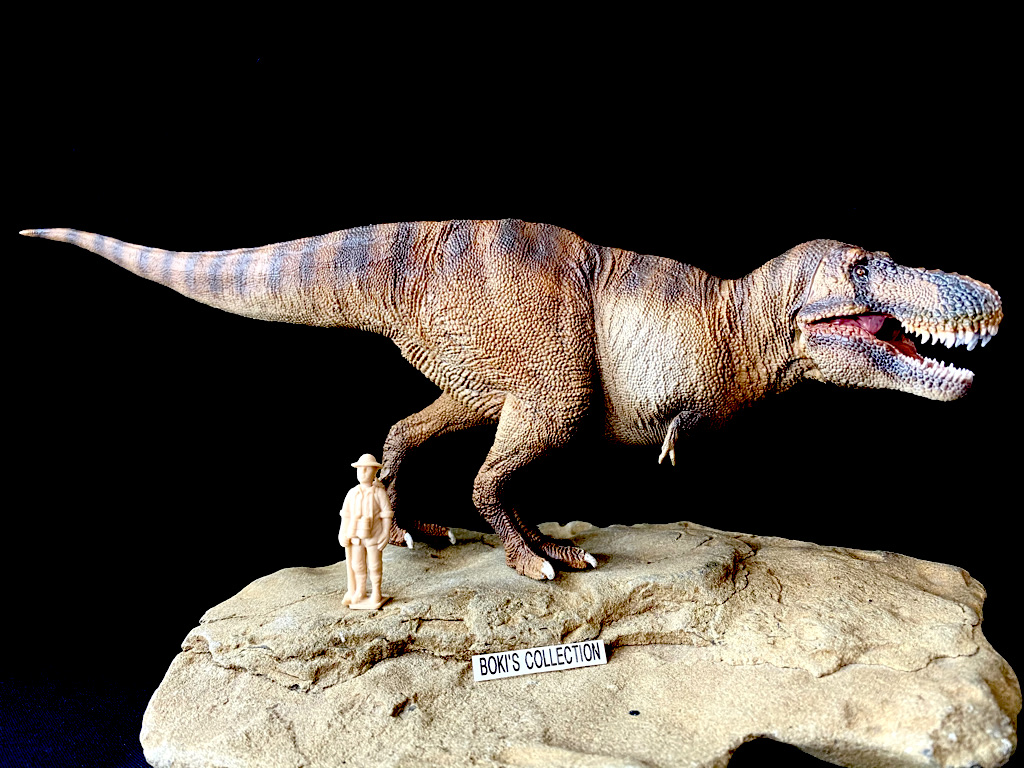
The colors chosen are nice and appropriate for a large animal. The brown that dominates the body’s upper half is of a chestnut hue highlighted by lighter shades here and there. The lower half is a very light tan color that slowly merge and transition with the darker upper half, and on the middle point where these two colors collide, a light-yellow wash brings it all together into a seamless tapestry.On the back, we see dark brown stripes that runs the entire length of the back and all the way down the tail where they form bands. On the face, a dark, almost black color outline the snout, jaws, and eyes. Like the majority of PNSO figures, the layering, blending, and transition of colors is top of the line.
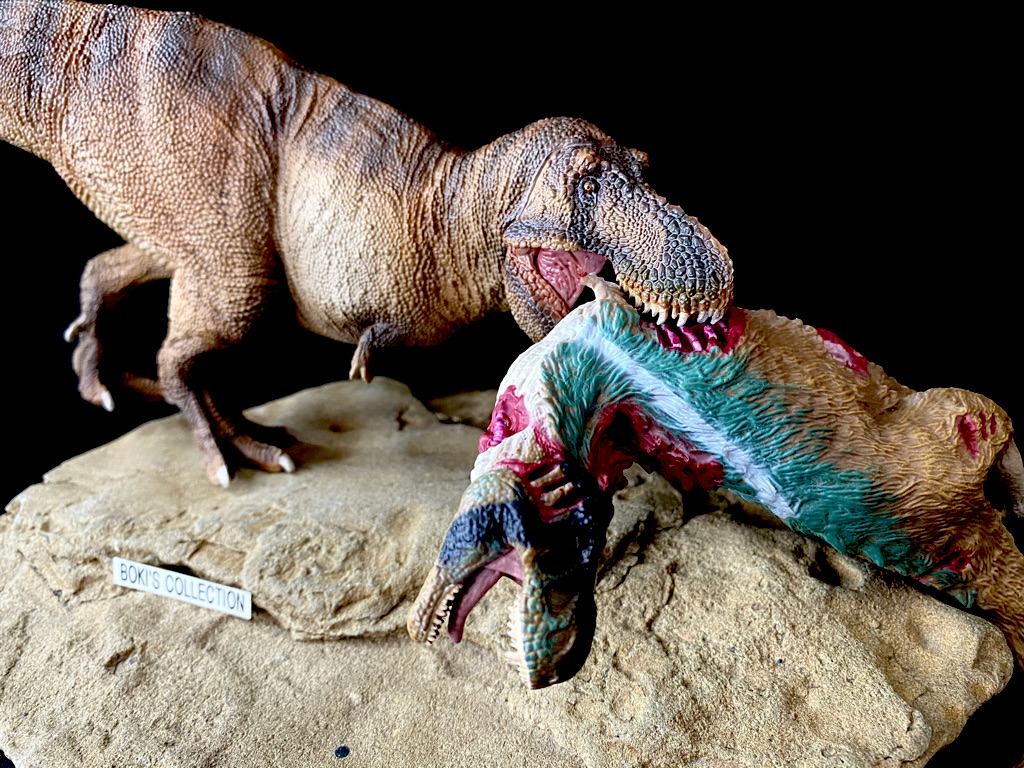
The figure is based on the American Museum of Natural History Tyrannosaurus rex skeleton AMNH5027, the first skeleton of this iconic dinosaur to be reconstructed and mounted for display. This skeleton fossil is almost complete at 45% including the skull. The figure was sculpted during the museum’s special exhibit T. rex: The Ultimate Predator which opened in March 2019 and will be up for two years ending this year March 14,2021.
The figure itself is sculpted by famed PNSO artist Mr. ZHAO. When it comes to major brands, it is very rare to actually know who the artist are, let alone to hear what they have to say about the choices and decisions they have made in sculpting a figure. The artist released a YouTube video where he talks about the process and address the two most talked about features: the scales and the lips, giving us a rare opportunity to understand his reasonings.
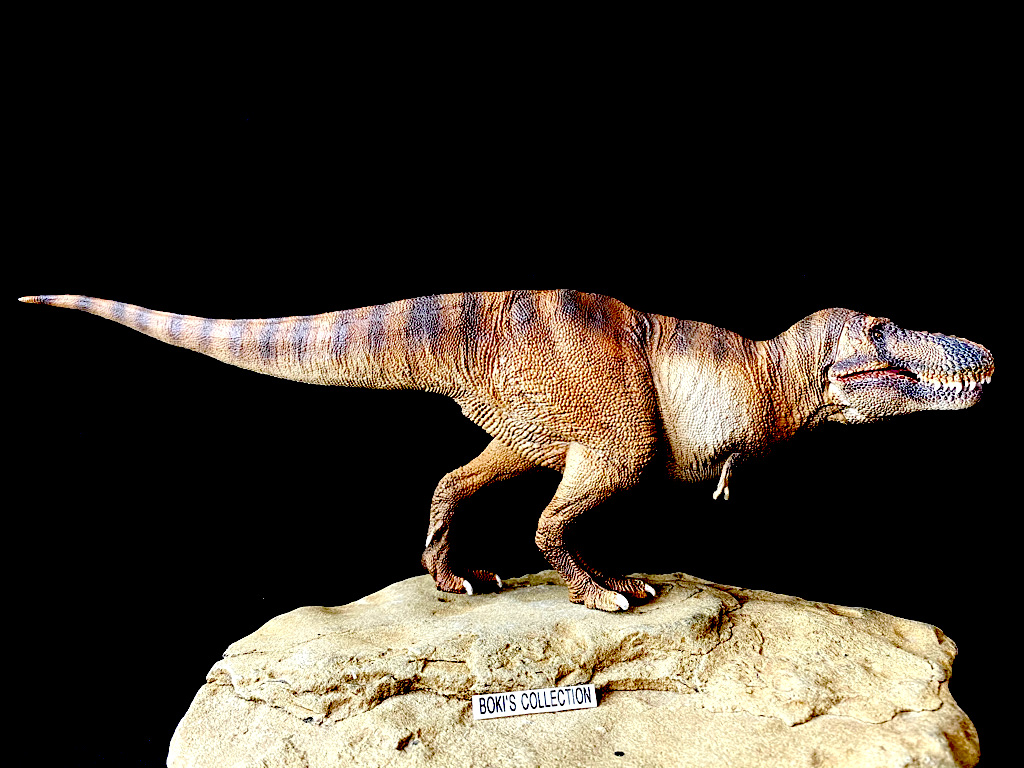
Below is some of the facts and information from the video that forum member Acro-man has generously translated and allowed me to include in this review. Wither you agree or not, it does gives us a pretty good idea of the thoughts behind this figure:
- The figure is based on AMNH5027 skeleton- working with the museum, the skeleton was scanned and then added flesh. 2. The AMNH5027 skeleton mount on display had 50 caudal vertebrae. this was corrected in the figure by decreasing the number to 40 due to the more complete tail found in Sue. 3.The nostrils are placed more in front and slightly lower. 4. The arms looks shorter than usual because of the upper arms were hidden under skin folds. 5. he toenails also looks smaller because a large part of it is inside the big fat foot cushion very much like that of an ostrich
Why lipless: 1. in general, T. rex has more similarities with crocodiles than lizards. 2.There are mesh impressions found on the T. rex face streatching to the edge of the mouth, meaning huge scales used to directly cover the roots of the tooth similar to a crocodile. 3. T. rex’s upper jaw is much wider than its lower jaw and they function like a pliers- fixing the meat and tearing it violently, very different than modern lizard’s more gentle way of eating. So, lizards are not a very good benchmark for reconstructing T. rex. 4. When the mouth is closed, the shape of the upper and lower jaw matches perfectly and there are small holes on the upper jaw for each lower teeth to fit in, while modern lizards don’t have matched jaws and that’s why they need lips.(Notes: If you look inside the mouth, you can see these holes in the upper jaw where the lower teeth fits in perfectly)
Skin impressions : 1. Little skin impressions were discovered for T. rex, but a lot for some of its relatives such as Tarbosaurus and Albertosaurus which is what was used as a base for this figure. 2. The head – as mentioned before, huge scales cover the face. Look closer and you will see small trigeminal nerve-holes (provides both sensory and motor nerve supply to the face) on these scales which gives them the sensitivity of a human fingers. 3. The neck – the skin impression on the back of the neck looks like a plucked chicken skin. Many believe it implies feathers , but so far no conclusion. 4. The back – there are asymmetrically arangnged trenches separating the skin into individual “scale clusters” like a leaf stems. Each clusters consist of small, randomly-shaped scales in millimeters in size.5. The Sides – mainly small scales in the 5mm-10mm size range, pentagon and hexagon in shape. There are also a few bigger scales in 20mm, the closer to the belly, the larger these scales become. 6. The Belly – thick square-shaped scales (taken/based on Albertosaurus skin sample)
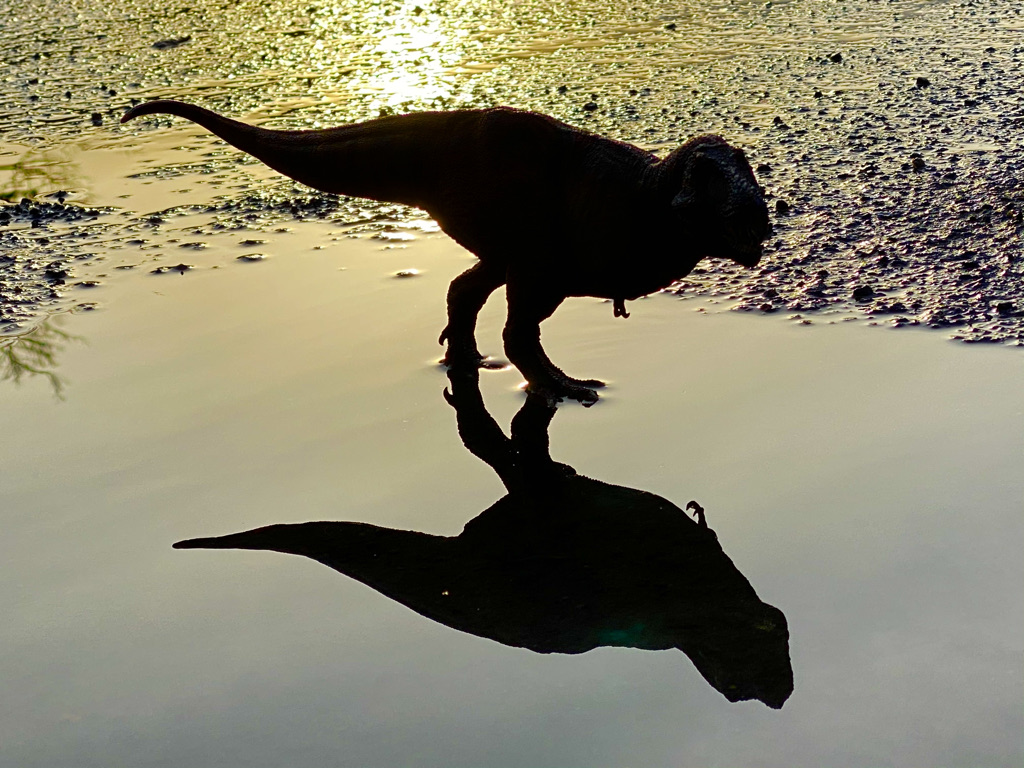
While Wilson v3 is far from being the definitive version, it is currently the closest, and at least in my collection the quintessential figure representing the scaly Tyrannosaur out right now. Despite its shortfalls, it is truly a beautiful and well sculpted figure that warrants an in-person observation to truly appreciate all of these minute details that are hard to capture in photos. This figure is Truly a well-researched and executed model.
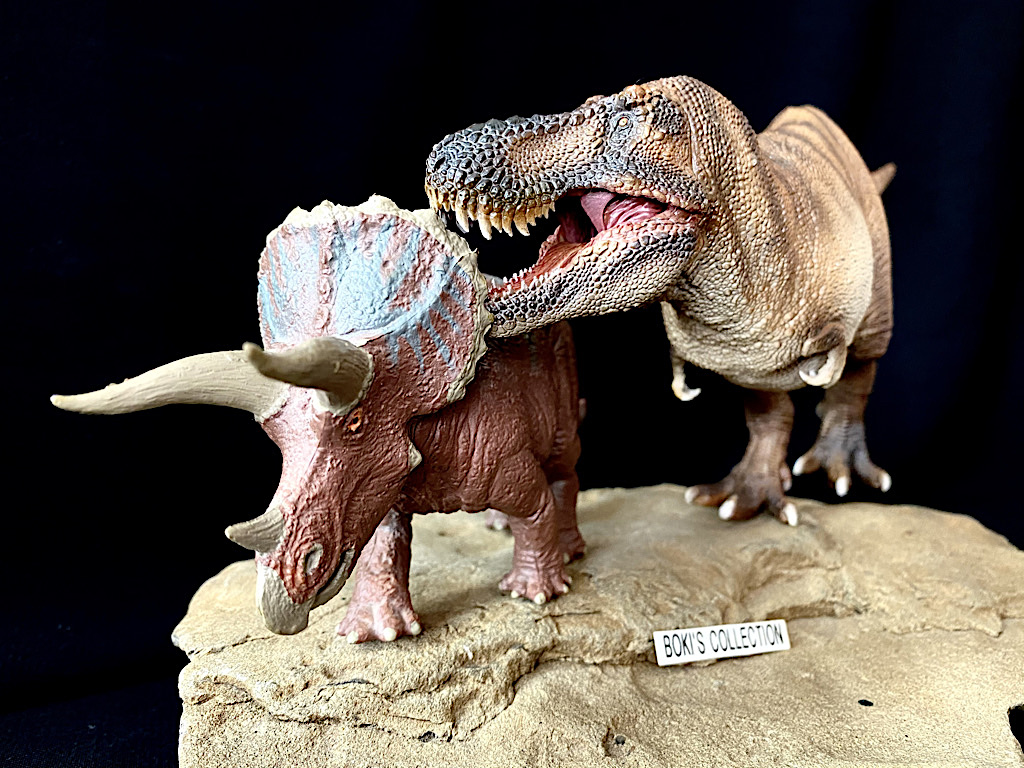
Will we see a definitive one soon?All of its best predecessors were once regarded as “definitive” figures of that time that captured what was then the consensus.Definitive is fleeting when used to describe a toy figure or model as science moves with time and technology. And like time, what is today’s consensus could easily be obsolete tomorrow as we have seen time and time again.
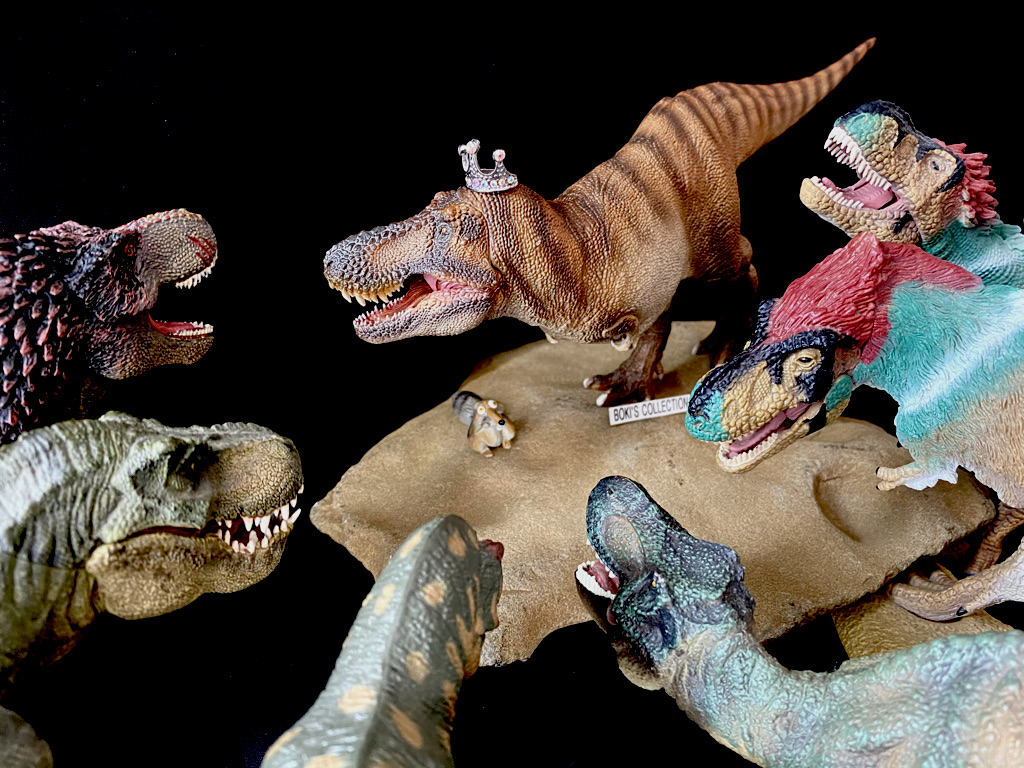
In the case of Tyrannosaurus rex, I also highly doubt that a definitive one would be seen anytime soon despite all of the evidence. I say this because Tyrannosaurus rex is simply too lucrative. A company putting out a “definitive” version is like butchering the goose that lays the golden egg, right? Once a perfect figure is put out, where do you go from there?
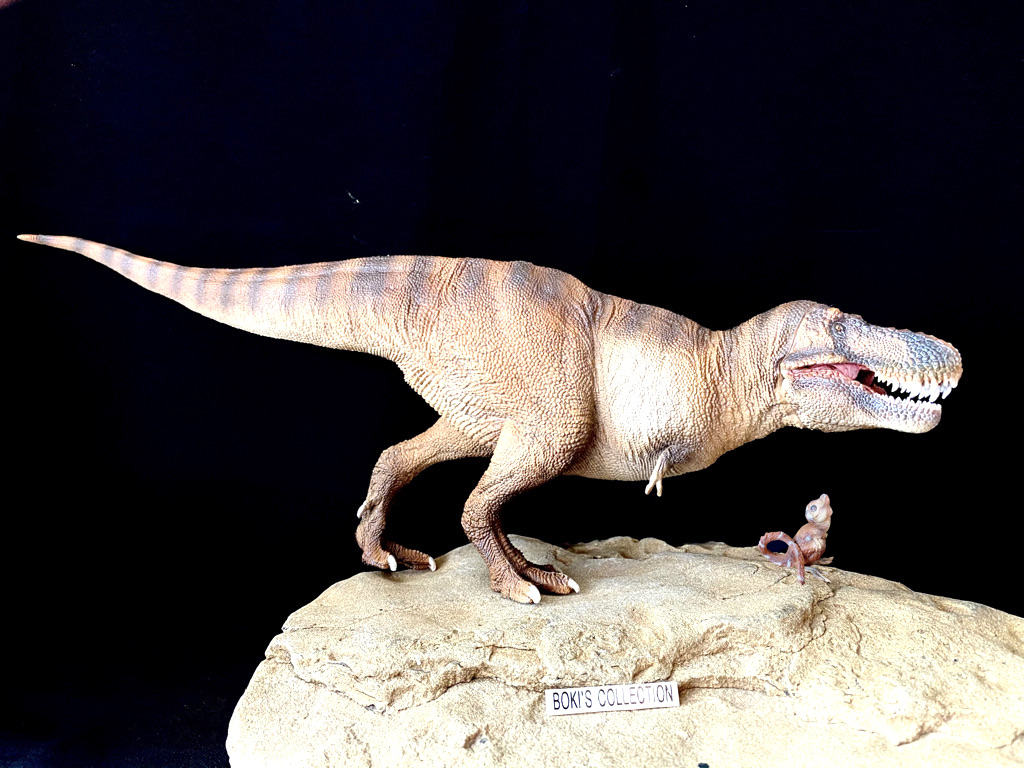
When PNSO releases another Tyrannosaurus rex, and we all know they will (just like every company out there), I suspect that it would be a feathered version and not another Wilson. After all, we already have little fluffy Aaron and he will have to grow up sometime, right? It a good bet that he will grow up and be Wilson’s successor. So, until the times comes, whenever that may be, we will just have to enjoy what we currently have and look forward to that time when a definitive version of the Tyrant King finally makes its appearance.
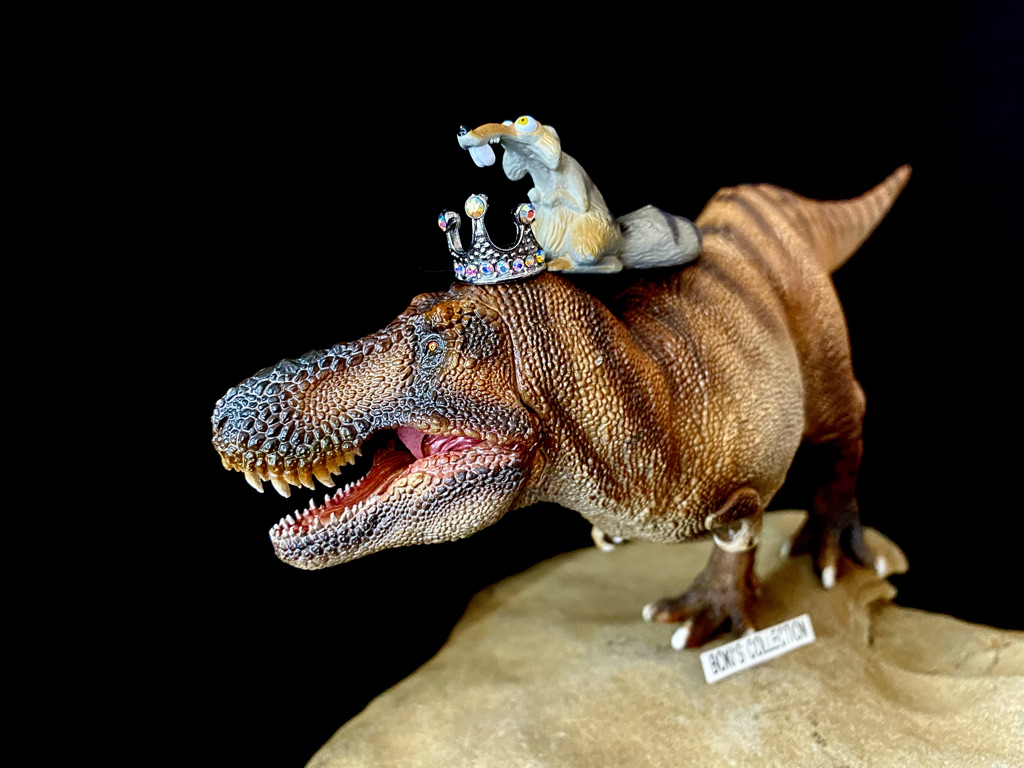
Well, sorry for the long review, but hope you enjoyed it. Thanks for reading and until the next review, please stay safe and healthy! Cheers!
Disclaimer: links to Ebay and Amazon on the DinoToyBlog are affiliate links, so we make a small commission if you use them. Thanks for supporting us!





Nice highly scientific figure of tyrannosaurus. Now you provide much more scientific data that explains the accuracy or not of said prehistoric animal. Superb article.
Great review, it’s a nice figure for sure and very tempting, but I’m perhaps going to be contrarian and say that I still prefer the Safari Feathered Rex. Something about this one just seems “off” to me, and I’m not talking about the overall bulk or scales or the typical stuff. Proportionally something about it just doesn’t click, I’m not going to say the reconstruction is wrong because I’m just a layman, but these days with limited self space and other financial concerns the aesthetics of the figures I buy is just as important as accuracy, especially given that what is accurate is changing faster than ever these days.
I was quite aware of the pro’s and con’s of the current debate regarding scale size depiction , feathers and lips, but when I saw this figure, there was no way I was not going to buy it. It is a splendid piece. Definitive? … well. the goal posts have been moving for years, so, I’m not holding my breath. This joins the line of terrific depictions and was a worthy, if expensive, addition to my collection. I’m looking forward to your review of “Wilson 2” when you are able to put that together, Boki.
Congratulations. What a Monster of a Review! This is an outstanding Job you did on the King of Tyrannosaurs.
If a Massproduced Figure fits perfectly into a natural enviroment and does not look like its in the wrong place, you can truely call it a Masterpiece in my Opinion. You can like the Figure, or not. But it it still a Masterpiece then. But you already found the perfect words regarding the “definitive” term.
” it’s difficult to catch up or even stop and fully admire them all without too much noisy distraction.”
Thank you very much for this long (great!) and pleasing to the eye Review.
Very thorough review. Very well done. I have mixed feelings about this figure. The head looks a bit weird shaped to me. And i’m not a big believer in this current bulky bodied look for T Rex that is in favour these days.
Most large animals do everything they can to shed weight, not pack it on. This would be especially important for predators, which need to be somewhat fast and agile and even more so for bipeds as they are more prone to falling down. More weight means more chance of severe injury.
Not to mention extra bulk requires more food to maintain it. There’s just no good reason to be a bulky predator in nature, unless you are going to hibernate. Doubtful for Rex.
Rex’s big bone structure can be explained in another way, other than meaning it carried a bulky body. Big bones would offer protection from the rough and tumble lifestyle, that a large bipedal predator would undoubtedly live. A robust skeleton offers extra protection from the daily stress and tumbles that would surely have been encountered. I still believe in a shrink wrapped T-rex.
I also feel that the tail is too short on this figure. With its massive head and new bulk to counterbalance, the short tail just doesn’t have the mass and if this figure were alive it looks like it would do a face plant every time it held itself horizontal to the ground.
Science doesn’t work according to your personal preferences or beliefs. The current chunky restoration of T. rex is based on years of meticulous research carried out by multiple experts. The slim, shrink-wrapped look went out with the 1990s. Moreover, carnivorous dinosaurs didn’t live according to the rules of extant animals. Nor did herbivorous dinosaurs for that matter. Even a 9-10 T. rex still would have been able to move faster than a Triceratops.
Fair enough. But I bet the look of T Rex 10-20 years from now is different than it is today. The experts gave it an upright posture at one time and then they made it shrink wrapped. Then they gave it a bunch of feathers and then just a trace of feathers down the back. Now it’s bulky. One day some new idea, some new discovery, some new research may well change it again.
And the laws of physics don’t change just because an animal isn’t extant. Bulk means weight, weight means less speed, less agility, more food required to maintain that weight and much harder impact forces from a fall. None of which are beneficial and all of which will be selected against. eg a less bulky, quicker, more agile Rex will be able to out compete big bulky slow T Rex’s for food.
And 4 legged animals are usually faster than 2 legged animals; so being a biped, T Rex was already at a bit of a disadvantage…Triceratops may have been able to outrun a bulky T Rex but have less of a chance of outrunning a trim one.
But I admit, this is purely my opinion; I could be completely wrong. Maybe T Rex were like lions where the big ones (ie the male lion) have a haram of smaller ones (ie lionesses) to do the hunting for them…..the hunting they can’t do because their size makes them too slow and too easy for prey to spot them from a distance.
No, that’s really not how the laws of physics work when it comes to an animal’s size or its food intake. Elephants, giraffes, bovids, horses, and other large extant animals can suffer serious or even lethal injuries from falls while running, yet they do it regardless. Also, are you aware that T. rex has been shown to be more agile than any other large theropod?
Food intake depends on a number factors, including an animal’s metabolism and the efficiency of its digestive system. Elephants need to eat constantly in part because their bodies don’t break down plant material all that well. As a hyper carnivore, T. rex is thought to have been able to break down meat and bone much more effectively.
And since when are quadrupedal dinosaurs faster than bipedal ones? That goes against everything we know about them.
Those extant 4 legged animal you named are less likely to fall than a Rex. Rex being a predator, bipedal (and thus less stable on its feet and more prone to falling) and having to regularly hunt for food is going to be chasing and grappling with prey (and potentially huge prey) on a regular basis. Falls would probably be par for the course. How often do running elephants fall? Very rarely…..because they are more stable on their feet and don’t run nearly as often and when they do they usually run in a straight line. 2 legged Rex would be running every time it hunted and probably twisting and turning as it did.
Regardless of metabolism, digestive ability etc a bulky Rex would still have to consume a lot more food than a lean and mean Rex, meaning it would have to hunt more, which means putting itself at risk more often to injury during the hunt and a greater need for food. Selective pressures would always favour a leaner Rex whose food requirements were less.
Ostriches are bipedal and can run an impressive 45 mph for short sprints. But that is small potatoes compared to many 4 legged animals. Many antelope and gazelle, cheetahs (of course) and lionesses can outrun an ostrich. And an ostrich isn’t build like a predator with big muscles and jaws for killing. Ostriches are built for speed yet can still be outrun by many 4 legged animals. Animals with 4 legs often have a speed advantage simply because they have 4 legs to propel them instead of 2. There is no reason to expect anything would have been different in the dinosaur world.
I just can’t see any advantage to Rex being big and bulky and lots of disadvantages. So, in my view, natural selection would favour a lean Rex with big thick bones to protect from injury.
Terrific review of a terrific Tyrannosaurus rex!